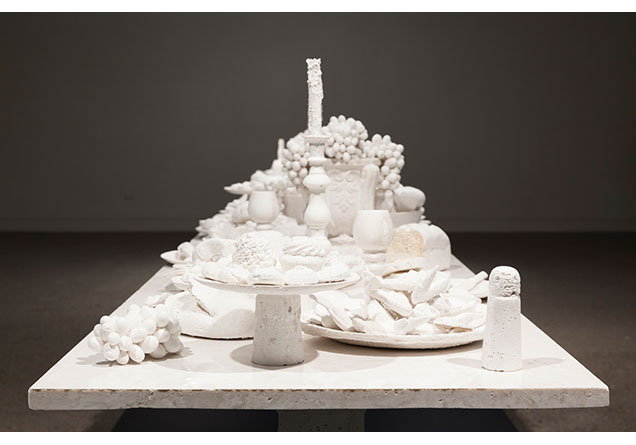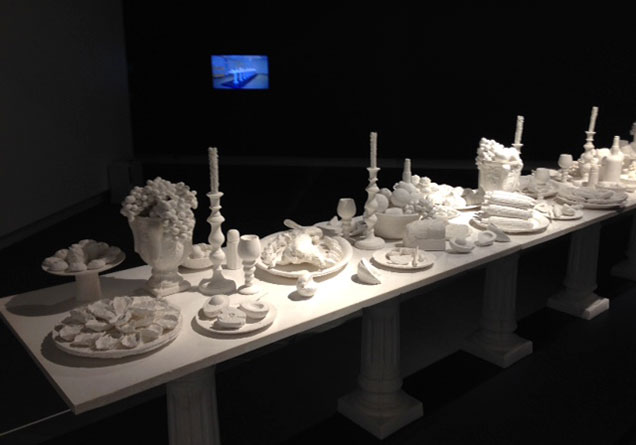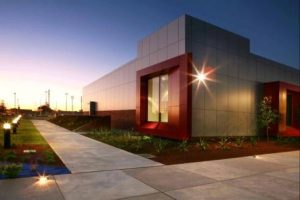SHOWCASE highlights the work of contemporary young artists and curators we work with and whose work you will see in museums and galleries across NSW and beyond in the near future.
Ken + Julia Yonetani’s work explores our relationship with nature, science and the spiritual realm in the contemporary age.
Ken + Julia have exhibited widely both in Australia and internationally, inlcuding at the 2009 Venice Biennale and the 2013 Singapore Biennale.
M&G spoke with Ken and Julia about their work and the touring exhibition Ken + Julia Yonetani: The Last Supper, currently on show at Tweed Regional Gallery.
RA: The Last Supper is a spectacular nine metre long banquet table made from one tonne of Murray River salt. You have worked with salt since undertaking a residency in Mildura in 2010, what was it about this experience that had such a significant impact on your interests and has shaped your work going forward?
JY: We were originally asked if we were interested in undertaking a residency in Mildura by the Palimpsest curator, Helen Vivian. She had seen the Sweet Barrier Reef, our installation made from sugar, at the Venice Biennale, and suggested we may be interested in doing something similarly related to environmental issues in salt. The residency in Mildura really opened our eyes to the inert fragility and resilience of Australian country. We learnt a lot about the life of the river, and the ebb and flow of water and salt, throughout history. We also learnt about the Salt Interception Scheme, which is basically the attempt to save a broken river system through chemotherapy. Over half a million tonnes of salty groundwater is extracted every year from points across the river system to stop the highly saline water from seeping into the river system, but this is a treatment rather than a cure. Our work is made from the salt harvested from this extracted groundwater.
Mildura is a kind of irrigation oasis in the middle of the desert. It is a vision that was originally the result of two Canadians in fact, William Benjamin Chaffey and George Chaffey, known locally here as the ‘Chaffey brothers’. The Chaffey brothers established irrigation towns in various parts of California. They brought their dream of turning desert into lush productive farmland to Australia. In one sense, they succeeded. But with every step of the way they also struggled with the material of salt. For every drop of water that was poured across plains, and every tree that was felled in the process, the Australian desert’s highly saline groundwater swelled. It surged up to the surface in some areas, and seeped into the river system in others. Mildura is on the bank of the Murray Darling river, one of the longest river systems in the world. Compacted with drought, recently the Murray has periodically become so salty that the river ecosystem collapses, and the water downstream becomes undrinkable.
We worked with scientists studying the impact of salinity on the environment in the area. Then we decided to make a three dimensional Still Life tableau out of salt. This seemed to have lots of interesting connotations, with the rise of the agricultural revolution in Renaissance Europe, and the emergence of the art form of the Still Life. It was called Still Life: the food bowl, because the farmland on the Murray River is often revered to as Australia’s ‘food bowl’.
Now we have taken this concept much further, to produce a nine-metre-long banquet table made entirely from salt. Here the issues we feel widen, as salt becomes a metaphor not only of the impacts of salinity, but broader issues of food security and food safety in an increasingly toxic world.
The residency in Mildura really opened our eyes to the inert fragility and resilience of Australian country.
RA: Audiences love your work. Your installations are awe-inspiring and stunningly beautiful. However your work does address some very serious issues such as food scarcity, a looming energy crisis and the degradation of the environment. You have even referred to your work as ‘Armageddon artwork’. How do you strike a balance between these weighty concepts and the visual integrity of a work?
JY: We like to examine issues relevant to our future and the planet’s future, but not in a way that is dictatorial, didactic, or boring.
In a way, our work is ‘Armageddon artwork’, because it is an expression of our own anxieties about the future. But we hope it is also embedded with hope, laughter, and of course beauty. It is not necessarily about striking a balance between concept and beauty, rather it is beauty which enables the audience to interact and be drawn in to the concept.
In 2013, at the Singapore Biennale, we premiered the complete version of Crystal Palace: the great exhibition of the works of industry of all nuclear nations, a massive installation of 31 chandeliers, one for each country with nuclear power. Our work sparked controversy, and most importantly intense interest from the audience. It featured in many of the Biennale’s top pick lists, and was the subject of several feature articles in the Straits Times. In one of these articles, journalist Clara Choy concludes:
“I cannot help but admire Crystal Palace’s guts…Its masterful treading of the border between beauty and panic. One way or another it has altered me. And that is the most any piece of art can hope to do.” (12 Nov 2013)
RA: After 20 years of marriage and five years’ working collaboratively I am interested to understand the practicalities of working together. Do you each have set roles in the development of an artwork?
JY: Some things we do together and some things we do separately. Definitely the initial concept stage is more a ‘slinging match’ and very much collaborative, as we both bounce ideas off each other and express our opinions about what would and wouldn’t work. In realising a project, however, we do have separate tasks, and we try to separate them according to what we do best. Ken is very hands-on and practical, whereas I do the research and development, though sometimes we also reverse these roles.
RA: Working collaboratively brings together the unique influences of both Australia and Japan. What influence do these two distinct perspectives have on your work?
JY: We are lucky that we have opportunities to spend time in both Japan and Australia. It gives us an important perspective on both countries, a place somewhere in-between from where we can see the good and bad in everything.
Japan maintains within its highly complicated self a pervading critique of modernity, multiple layers of time, culture, and meaning that enable an understanding and aesthetic that is not completely overridden by contemporary materialism. At the same time, having one foot inside Japan and another outside it, in a country like Australia, enables a perspective that can question the worst of Japan’s essentialising, collectivist, and conservative tendencies.
RA: Where can we find out more about your work?
JY: You can visit our website: www.kenandjuliayonetani.com. There’s also a recent monograph on our work published in English and French. It’s available on amazon UK.
Rachel Arndt. M&G NSW Gallery Programs and Touring Exhibitions Manager
A Hazelhurst Regional Gallery & Arts Centre commissioned project toured by Museums & Galleries of NSW.








